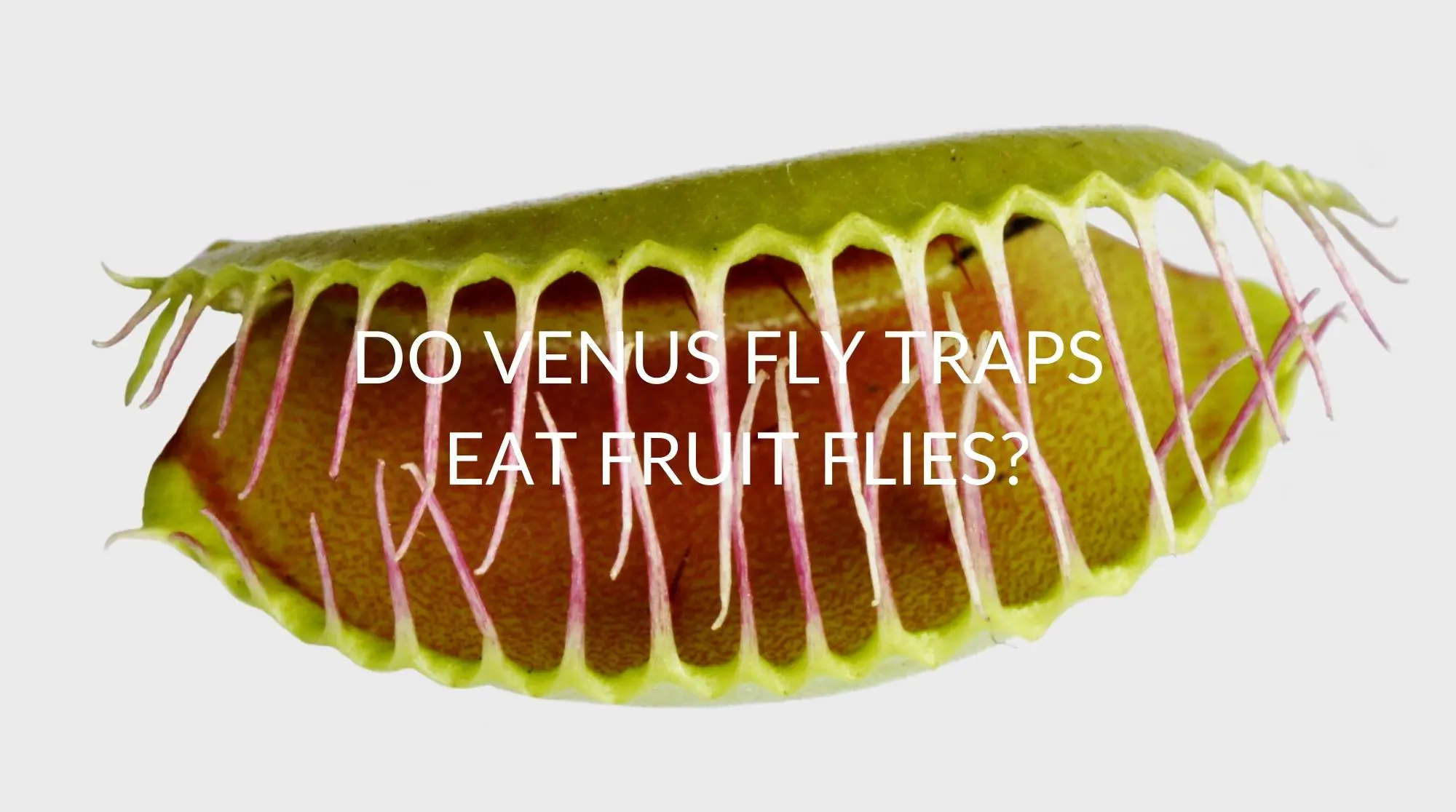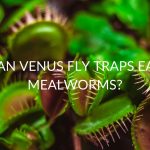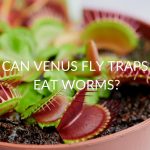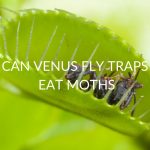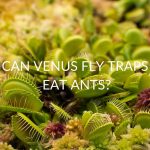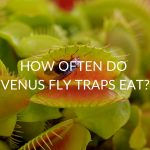Venus Flytraps are capable of eating fruit flies, but they are not the preferred food of Venus Flytraps. They work by fruit flies landing on their trap, stimulating their trigger hairs, and then closing their traps around their prey.
The rest of this article will go over if Venus Flytraps eat fruit flies and how many. It will also cover alternative solutions and carnivorous plants for fruit flies.
Do Venus Flytraps Get Rid of Flies?
Typically speaking, Venus Flytraps should only eat prey that is 1/3 of their trap size. If your Venus Flytrap has 1-inch traps, they will be able to eat flies, as well as gnats and ants. We will discuss Fruit Flies more in-depth, but they can eat different types of flies and other flying insects.
Unless you have a significant amount of Venus Flytraps or other carnivorous plants, they may not be the best option to get rid of an infestation of flies. You will need to discover what is causing the infestation to properly eliminate them. Venus Flytraps can work perfectly to rid yourself of the occasional house flies that come in through your door, though.
If you decide that flies may not be worthwhile, Venus Flytraps are particularly fond of mealworms and bloodworms. If they are freeze-dried, there are additional steps that you will need to take – rehydrating and stimulating the secondary response. You can also feed Venus Flytraps crickets from the pet store. If outdoors, Venus Flytraps are fully capable of catching their own food, so you don’t need to intervene.
Do Venus Flytraps Eat Fruit Flies?
Due to the size of fruit flies, Venus Flytraps are not the best choice if you want to control your fruit fly population. Fruit flies are small and quick. Venus Flytraps attract prey with a fruity scent. When prey touches the trap, it stimulates trigger hairs that activate the trap. Venus Flytraps must be stimulated twice to close securely.
Venus Flytraps have a slow and weak grasp, which allows fruit flies plenty of time to escape. They also have gaps in their trap until the secondary trigger is met, which again gives the fruit flies ample time to escape. Therefore, while Venus Flytraps can, in theory, eat fruit flies, they are not the best carnivorous plant to do so.
Wanna know whether Venus Flytraps can eat mealworms?
If you have already bought fruit flies for the purpose of feeding your Venus Flytrap, do not despair. You can place them in the freezer for a while. When they are dead or stunned sufficiently, you can then place a few into your Venus Flytrap, enough to equal 1/3 of the trap you are feeding. You will have to gently squeeze the trap to initiate the secondary response in order to effectively close the trap.
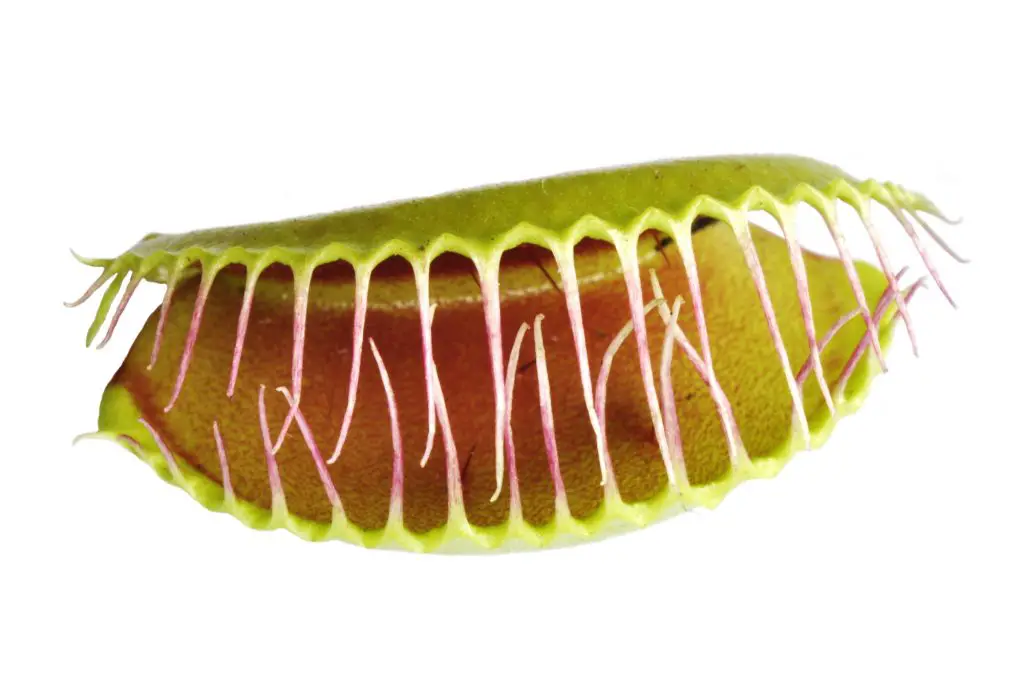
How Many Fruit Flies Can a Venus Flytrap eat?
While Venus Flytraps are not the most adept at catching fruit flies, they also are not voracious eaters. Venus Flytraps only need to eat once every other week. Further, for each of these feedings, only one of its traps needs to consume food. Therefore, you are talking about only two fruit flies being consumed every month, assuming they are able to catch the fruit fly in the first place.
To deal with a larger number of fruit flies, you can add more Venus Flytrap plants. You could choose to add different types of carnivorous plants as well if you would like variety. This will give you a variety in looks and a variety in ways that the carnivorous plant actually catches the food.
As mentioned above, depending on the size of your Venus Flytrap, you could kill fruit flies in the freezer. Then you could feed as many fruit flies that make up 1/3 the size of the trap. Ensure that you properly stimulate your Venus Flytrap’s trap in this scenario.
Other Carnivorous Plants to Control Fruit Flies
Perhaps you want more than just Venus Flytraps on your patio. Or maybe you are enthused with your Venus Flytrap and want to see what other carnivorous plants you can explore. Either way, continue reading for 7 additional possibilities.
Sundews (Drosera)
Not only are Sundews pretty to look at, but they’re also great at catching fruit flies. They’re like a living sticky trap. Their droplets serve as bait, and then the fruit flies get stuck against them. These plants are also easy to grow indoors and pretty to look at. They are pretty for outside use and can make themselves useful at catching wasps and bees, as well as fruit flies.
Carnivorous Pineapples (Carnivorous Bromeliads)
While only three species of bromeliads are carnivorous, they may be the perfect fit for you. These plants work by having the leaves create a barrel filled with water, where bugs are often caught and then suffocate. Carnivorous Pineapples come in many pretty colors and patterns, with Bromeliad Reducta sporting fine red stripes.
Cobra Lily (Darlingtonia Californica)
Cobra Lilies have an interesting way of capturing fruit flies. Insects are drawn to the tongue-like structure of the plant and find escape difficult after entering. This plant works by confusing its prey with sunlight shining through various parts of the trap. Its downward-pointing hairs impede them from climbing out as well. Its bright green color makes it a favorite among enthusiasts.
Butterworts (Pinguicula)
These plants digest bugs after they curl their leaves into cups. Unfortunately, Butterworts work only during the summer to trap insects, such as fruit flies. They do produce pretty flowers in the springtime, though.
Monkey Cups (Nepenthes)
Pitcher plants are sometimes called Monkey Cups. They got their name because, in the wild, monkeys can be seen drinking from them. Pitcher plants have slippery edges on their tube-shaped traps, which are filled with digestive fluid. Pitcher plants are not ideal for the indoors due to their need for a greenhouse or bog, and they give off an unpleasant smell when they are digesting bugs.
Catapulting Flypaper Trap (Drosera Glanduligera)
The Catapulting Flypaper Trap is unique because its tacky arms act as catapults. When the fruit fly touches one of its arms, it breaks, snapping back towards the center, where the plant can then devour it. The Catapulting Flypaper Trap can be difficult to grow and cultivate.
Rainbow Plants (Byblis)
This beautiful, carnivorous plant has sparkling, wispy leaves and delicate flowers. Its name is derived from its adhesive-covered leaves, which shimmer in the sunlight. Like flypaper, fruit flies that land on the rainbow plant are unable to leave and provide nourishment to the plant instead.
Best Ways to Control Fruit Flies
Maybe you don’t want a carnivorous plant, or you have too many fruit flies for your plants to eat; either way, there are other options available to you. First, you need to determine if there is an infestation or why you have fruit flies. One place you may not think to check is your kitchen sink, so be sure to look there as well.
Here are 7 different methods you can try in order to control fruit flies.
Dealing with Drain Fruit Flies
Food left in your drain after doing dishes can attract fruit flies. Use a drain brush to remove build-up so that more flies are not attracted after you deal with the issue. You can use a drain-cleaning solution or make your own.
To make your own drain cleaning mixture, mix a ½-cup of salt, ½ cup of baking soda, and one cup of vinegar. Pour it down the drain. Wait a few hours and then pour boiling hot water down.
Sticky Fly Traps
Hang these ribbons of tape around your plant. Fruit Flies will be unable to escape once they touch the sticky flytrap.
Clean Up Your Plant
Inspect your plant and remove any damaged or rotting fruits and leaves. If this is drawing fruit flies to your plant, they will keep coming back if there is a source for them.
Bowl of Death
In a bowl, mix a few drops of dish soap with apple cider vinegar. Microwave the mixture for 30 seconds, which will release more of its smell to attract the fruit flies. Leave the bowl out, and the fruit flies will drown in the bowl.
Jar of Death
Create a jar trap with 1 inch of beer and 1 inch of cider vinegar. Use a rubber band to secure a Ziploc bag over the jar with a corner pointed down into the jar. You then poke a 1/8-inch hole in the corner. The beer’s scent will attract the fruit flies, who won’t be able to escape your makeshift funnel, and they will eventually drown in the beer/vinegar.
Topical Insecticides
If you are trying to remove fruit flies from your plants, you can consider an insecticide with permethrin in it. One popular choice is the Take Down Garden Spray, which is safe for carnivorous plants.
Paper Cone and Old Fruit
Place very ripe fruit into a jar. Roll a piece of paper into a cone shape and stick the narrow side down into the jar. The rotting fruit will attract flies, but the cone of paper will make it difficult for them to get out.
Recap
Now you know that Venus Flytraps can eat fruit flies, but due to the way Venus Flytraps work, they are not the ideal candidate to deal with fruit flies. If you are looking to feed fruit flies to a carnivorous plant, then Sundews are perhaps the best choice for you. These sticky little plants are perfect for capturing fruit flies. Similarly, Catapulting Flypaper Traps are a good choice if you want to easily watch the plant in action.
Perhaps having a large collection of different carnivorous plants is a good idea if you want to watch several fruit flies meet their demise at once. This will show you the different ways they work and test which one you find most effective. Maybe you are intrigued by the way that the Venus Flytrap shuts shut. Meanwhile, Monkey Cups and Carnivorous Pineapples provide an interesting slide effect.
Outside of carnivorous plants, there are options you can take to remedy fruit flies. If it is a true infestation, you need to discover where they are coming from and eliminate the source. Otherwise, more fruit flies will just take over after you kill the ones that are currently there. If your plant simply isn’t up to the task of eating that many fruit flies, you can do one of the at-home remedies mentioned above. Regardless, the interaction of carnivorous plants and fruit flies are interesting to watch.

